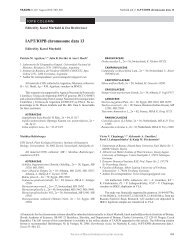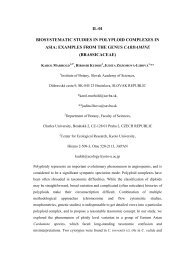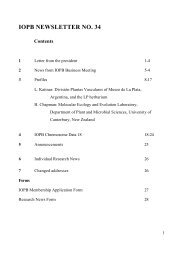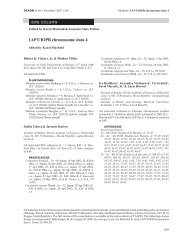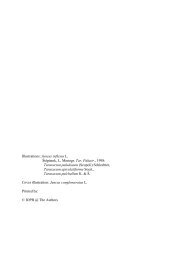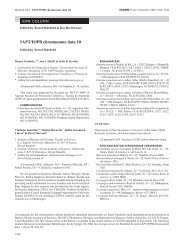CONTENS - International Organization of Plant Biosystematists
CONTENS - International Organization of Plant Biosystematists
CONTENS - International Organization of Plant Biosystematists
Create successful ePaper yourself
Turn your PDF publications into a flip-book with our unique Google optimized e-Paper software.
O 35<br />
Evolution <strong>of</strong> a RNA polymerase gene family in the polyploid<br />
Cerastium alpinum complex<br />
Anne Krag Brysting<br />
Centre for Ecological and Evolutionary Synthesis, Department <strong>of</strong> Biology, P.O.Box<br />
1066 Blindern, N-0316 Oslo, Norway; a.k.brysting@bio.uio.no<br />
The high-polyploid Cerastium alpinum complex (Caryophyllaceae) has been shaped<br />
through repeated hybridization and polyploidization events. By the use <strong>of</strong> a network<br />
algorithm and sequences <strong>of</strong> a single-copy nuclear region <strong>of</strong> the RNA polymerase II<br />
gene family RPB2, we have previously shown that it is possible to untangle genome<br />
mergings within this species complex. RPB2 nicely tracks the allopolyploid events<br />
that gave rise to several recent (late Pleistocene) octo- and dodecaploid taxa.<br />
However, only remnants <strong>of</strong> one or more earlier tetraploidization events are present as<br />
pseudogenes in some <strong>of</strong> the supposed tetraploid ancestral taxa. Here, new data from<br />
a non-coding region <strong>of</strong> the RNA polymerase IV gene family RPD2 is presented. In<br />
some eudicot angiosperm taxa (e.g. Arabidopsis, Silene and Viola) this gene has<br />
been independently duplicated. In some lineages subfunctionalization or<br />
ne<strong>of</strong>unctionalization <strong>of</strong> the two paralogues has occurred (probably specializing on the<br />
two different RNA polymerase IV types existing in angiosperms), and in other<br />
lineages one paralogue has become pseudogenised or completely lost. RPD2 is<br />
duplicated also in Cerastium; two very different paralogues were amplified for all<br />
analysed taxa, and for each <strong>of</strong> these paralogues several copies exist depending on<br />
the ploidy level <strong>of</strong> the particular taxon. In the talk, I will present the most recent data<br />
and in the light <strong>of</strong> results from other studies (Silene and Viola) discuss the fate <strong>of</strong> the<br />
different paralogues following genome merging in the allopolyploid Cerastium<br />
alpinum complex.<br />
36



